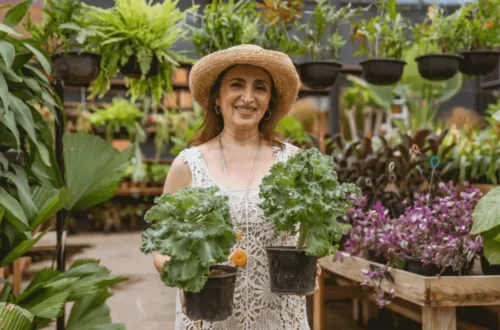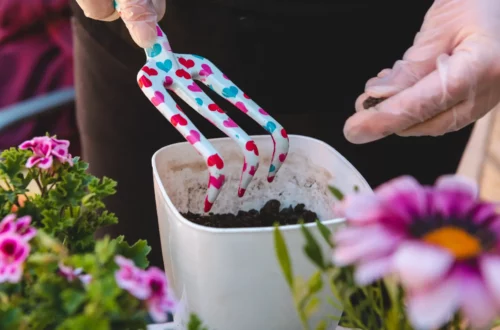Understanding Sustainable Horticulture: A Guide to Environmentally-Friendly Plant Growth

Imagine stepping into a garden bursting with vibrant colors, flourishing plants, and a thriving ecosystem. Now, picture achieving this picturesque vision while minimizing harm to the environment. Sustainable horticulture, my friend, is the key to making this dream a reality.
But what exactly is sustainable horticulture? Simply put, it’s an approach to plant growth that embraces eco-friendly practices, prioritizing environmental stewardship and minimizing the use of harmful chemicals. It’s about working in harmony with nature rather than against it.
In this article, we will dive deep into the world of sustainable horticulture and uncover the secrets to creating an environmentally friendly garden paradise. Whether you’re a home gardener looking for effective techniques or a green enthusiast seeking to minimize your ecological impact, this guide has got you covered.
Let’s dive into the fascinating world of sustainable horticulture and witness firsthand how our gardens can bloom sustainably, one plant at a time.
Introduction to Sustainable Horticulture
Sustainable horticulture is a practice that emphasizes environmental conservation while promoting the growth and cultivation of plants. It goes beyond conventional gardening methods and embraces eco-friendly techniques that minimize harm to the environment.
In sustainable horticulture, the goal is to create a balance between plant growth and the preservation of natural resources. This approach takes into consideration factors such as soil health, water conservation, and the use of organic fertilizers. By adopting sustainable practices, gardeners can minimize their ecological footprint and contribute to a healthier and more sustainable planet.
The significance of sustainable horticulture lies in its ability to protect and restore the environment. It promotes biodiversity, conserves water, reduces soil erosion, and minimizes the use of harmful chemicals. Sustainable horticulture plays a crucial role in mitigating the impact of climate change and preserving ecosystems.
By practicing sustainable horticulture, gardeners can not only grow beautiful and healthy plants but also contribute to the greater good of the environment. Whether you are a home gardener or a professional horticulturist, embracing sustainable gardening methods is an effective way to create a greener and more sustainable future.
Also read: Creating a Pollinator Garden: 10 Essential Tips
Principles of Sustainable Horticulture
Sustainable horticulture is founded on a set of principles and practices that prioritize environmental stewardship while ensuring the successful growth of plants. By integrating these principles into your gardening routine, you can create a thriving garden while minimizing harm to the environment. Let’s explore some of the key principles of sustainable horticulture:
Minimizing Chemical Use
One of the fundamental principles of sustainable horticulture is minimizing the use of chemicals. Instead of relying on synthetic pesticides and fertilizers that can harm the environment and disrupt the ecological balance, consider adopting organic and natural alternatives. By using organic fertilizers and implementing natural pest control methods, you can promote healthier plants without compromising the ecosystem.
Resource Efficiency
Resource efficiency plays a crucial role in sustainable horticulture. It involves utilizing water, energy, and other resources judiciously to minimize waste. Implementing practices like drip irrigation, mulching, and proper soil management can help conserve water and enhance the overall efficiency of resource usage in your garden.
Biodiversity Conservation
An important aspect of sustainable horticulture is promoting biodiversity within your garden. Encouraging a variety of plant species and providing habitats for beneficial insects and wildlife helps maintain a balanced ecosystem. By creating a diverse and resilient garden, you can reduce the reliance on chemical inputs and foster a natural balance.
Soil Health and Conservation
Healthy soil is the foundation for successful plant growth. Sustainable horticulture emphasizes the importance of building and maintaining healthy soil through practices like composting, crop rotation, and minimal tillage. These practices enhance soil fertility, promote beneficial microorganisms, and reduce erosion, ensuring long-term productivity and sustainability.
Education and Continuous Learning
Practicing sustainable horticulture requires staying informed about the latest research and techniques. Being open to learning and continuously improving your knowledge about eco-friendly gardening methods is essential in achieving long-term success. Stay connected with reputable horticultural organizations, attend workshops, and collaborate with fellow gardeners to exchange ideas and experiences.
By embracing these principles of sustainable horticulture, you can create a beautiful garden that harmonizes with nature while minimizing environmental impact. These practices will not only benefit your plants and garden but also contribute to the preservation of our precious ecosystem.
Benefits of Sustainable Horticulture
Practicing sustainable horticulture offers numerous advantages, both for the environment and plant health. By embracing eco-friendly gardening methods, you can create a garden that thrives while minimizing harm to the planet. Here are some key benefits of sustainable horticulture:
1. Environmental Protection: Sustainable gardening practices help conserve natural resources, reduce pollution, and protect biodiversity. By minimizing the use of chemicals and adopting organic gardening methods, you contribute to a healthier ecosystem.
2. Improved Plant Health: Sustainable horticulture focuses on building healthy and resilient plants. By nurturing the soil with organic matter, using compost, and practicing crop rotation, you create an environment that supports strong plant growth and reduces the risk of disease and pests.
3. Long-Term Sustainability: Sustainable gardening methods prioritize long-term sustainability by conserving water, promoting soil health, and minimizing waste. By adopting these practices, you can maintain a beautiful garden while preserving resources for future generations.
Also read: A Comprehensive Guide to Organic Gardening for Newbies
Sustainable Gardening Techniques
Implementing sustainable gardening practices is crucial for reducing the environmental impact of horticulture. By utilizing organic fertilizers, composting, and natural pest control methods, you can create a garden that thrives while minimizing harm to the environment.
Organic Fertilizers: Nourishing the Soil Naturally
One of the key principles of sustainable gardening is minimizing the use of chemical fertilizers and instead opting for organic alternatives. Organic fertilizers, derived from natural sources like compost, manure, and plant extracts, provide essential nutrients to the soil without harming beneficial organisms. They improve soil fertility, promote healthy root development, and enhance plant growth. Consider using organically-based fertilizers to give your plants a perfect start in a sustainable way.
Composting: Turning Waste into Nutrient-Rich Gold
Composting is an effective way to minimize waste and create nutrient-rich soil for your garden. Collect kitchen scraps, yard waste, and other organic materials to create a compost heap or bin. Over time, these materials will decompose, transforming into nutrient-rich compost that can be used as a natural fertilizer for your plants. Composting not only reduces landfill waste but also adds valuable organic matter to the soil, improving its structure and water-holding capacity.
Natural Pest Control: Maintaining a Balance
In sustainable gardening, it’s essential to find environmentally-friendly ways to manage pests and diseases. Instead of relying on chemical pesticides, explore natural alternatives. Encourage beneficial insects, like ladybugs and lacewings, which can control harmful pests naturally. Companion planting, where specific plants are grown together for pest control, can also be effective. For instance, planting marigolds alongside vegetables can deter pests with their strong aroma. Additionally, practicing good garden hygiene, such as removing infested plants promptly, can help maintain a healthy and pest-free garden.
By implementing these sustainable gardening techniques in your own garden, you can contribute to the preservation of our environment while enjoying a flourishing and eco-friendly garden.
Also read: A Complete Guide to Year-Round Vegetable Gardening: 10 Steps for Success
Creating an Eco-Friendly Garden
Designing and maintaining an eco-friendly garden is not only beneficial for the environment but also allows you to create a serene and sustainable outdoor space. By incorporating sustainable practices into your gardening routine, you can minimize the negative impact on the ecosystem while still enjoying a beautiful garden. Here are some tips to help you create an eco-friendly garden:
1. Plant Selection:
Choose native plants that are well-suited to your region’s climate and soil conditions. Native plants require less water, fertilizer, and pesticides, making them more sustainable choices. Additionally, they provide habitat for local wildlife and help promote biodiversity.
2. Water Conservation:
Implement water-efficient irrigation systems such as drip irrigation or soaker hoses to reduce water wastage. Collect rainwater in barrels or underground tanks to use for watering your plants. Mulch around your plants to retain moisture and prevent evaporation.
3. Wildlife-Friendly Features:
Create a habitat for wildlife by incorporating features like birdhouses, birdbaths, and butterfly gardens. These elements attract beneficial insects and pollinators while providing a safe haven for local wildlife.
4. Natural Pest Control:
Instead of relying on chemical pesticides, use natural pest control methods. Encourage beneficial insects such as ladybugs and lacewings that prey on pests. Companion planting, which involves growing certain plants together that repel pests, is another effective strategy.
5. Organic Fertilizers:
Opt for organic and compost-based fertilizers that enrich the soil naturally without harming the environment. Compost kitchen scraps and yard waste to create nutrient-rich compost for your garden.
By following these eco-friendly gardening practices, you can create an oasis that supports a healthy ecosystem and minimizes harm to the environment. With a little planning and conscious effort, your garden can flourish while contributing to a sustainable future.
Also read: How to Grow a Sustainable Garden: A Beginner’s Guide
Conclusion
Sustainable horticulture is not just a passing trend, but a necessary practice to protect our environment and ensure the long-term health of our plants and ecosystems. By embracing eco-friendly gardening methods, we can create beautiful gardens that thrive while minimizing harm to the environment.
We encourage you to join the movement towards sustainable horticulture by implementing the following practices in your own garden:
1. Opt for organic and eco-friendly gardening products: Use organically-based fertilizers, compostable pots, and eco-friendly pest control methods to minimize the use of harmful chemicals.
2. Design an eco-friendly garden: Choose native plants that are well-suited to your climate and require less water and maintenance. Incorporate rainwater harvesting systems and create wildlife-friendly features, such as birdhouses and butterfly gardens, to encourage biodiversity.
3. Practice efficient water management: Install drip irrigation systems or use mulch to conserve water and prevent soil erosion. Water your plants during cooler times of the day to minimize evaporation.
4. Embrace sustainable farming techniques: Avoid excessive tilling and prioritize soil health by using compost and organic matter to improve fertility. Rotate crops to prevent nutrient depletion and pest buildup.
By following these sustainable gardening techniques, you can create a thriving garden that not only benefits you but also contributes to a healthier planet.
Remember, sustainable horticulture is not just an effective way to grow plants, but also our responsibility towards the environment.





